
Get up to 4 quotes by filling in only 1 quick form

Slash your energy bills by installing solar panels

We’ve helped over 500,000 homeowners reduce their carbon footprint
- GreenMatch
- Blog
- Solar Lights
Solar Lights
What are Solar Lights?
Solar energy products are diversifying as the industry continues to grow worldwide. One of the sought out solar products are solar lights. With these lights, you don’t have to pay for electricity and even more, no installation of wiring is needed. Simply unbox the lights and put them in the desired location, whether it would be inside the house or outside. Due to the fact that most solar lights have a built-in darkness sensor, there is no need to turn them on or off.
The solar light technology is improving rapidly. Indeed the lights are looking more attractive, have the ability to shine brighter, and can last for longer periods of time without running out of energy. In order to get a better understanding of solar lights, here are listed their main components
- Solar Panel – contains a PV cell inside which converts sunlight into electricity. Solar cells differ in size and thus the bigger the cell the more efficient the solar panel will be due to its increased power output. The solar cell is the most expensive component of a solar light, however with the advancement in PV technology the prices of these are decreasing.
- Battery – Stores electricity generated by the solar cells, which are directly connected to the battery by wires. The electricity flow from the solar cells to the battery is guaranteed due to a diode located between the cell and the battery. Nickel –metal hydride (NiMH) batteries are used often because they stand up better to the frequent charge and release cycles than standard nickel-cadmium batteries. NiMH batteries also have a significant environmental benefit, and can be disposed of easier. The battery is the second most costly component of a solar light.
- LED – Short for “light-emitting diodes” are installed in-line on an electrical circuit. Electrons moving through a semiconductor material is what creates the LED emitted light. Due to a lack of filament, the bulbs have an increased lifespan and do not waste heat. Sometimes manufacturers of solar lights increase brightness by combining LEDs with a small halogen bulb. But as LED technology improves, most manufacturers are shifting away from halogen in favor of all-LED solutions. The only exception is solar security light, which still requires the extra light intensity provided by halogen bulbs.
- Circuitry – This is an important component of the solar lights and in most cases is the one that most often separates the good solar lights from the bad. Wiring determines how efficiently the stored electricity is converted into light. A high quality circuit will result in a longer lasting and more effective solar light.
- Run Time – The run time, simply put, is the amount of time the solar lights will shine. Run times vary and can be as short as an hour or as long as a few days.
- Housing – Assembly of the solar light should be minimal. Usually, the solar panel will be an integral part of the light itself. However sometimes the solar panel is separate. This allows for installation of the light in the best location and mount the panel where it will get the most amount of sunlight.
Advantages of Solar Lights compared to conventional lights
- Powerful area light- solar lights shine a brighter light than most conventional light sources.
- Charges with A/C power- Can be charged with A/C power if the solar light is placed indoor where sunlight is not present.
- Stand or hang- Solar lights can be mounted on walls or can be positioned to stand on the ground, depending on the desired use.
- Easy to use on/off button – Solar lights have a manual on-off switch that turns the light on when the sun sets and off when it gets light again.
- Fits in a pocket – Small in size, solar lights can be transported easily and can even fit in your pocket!
How to Benefit the Most From Solar Lights
Location of solar lights is important for their efficiency. For maximum solar gain, the solar cell should be positioned at an angle so that it will be facing towards to the sun. There should be no structures obstructing the solar cell from harnessing sunlight. If the solar light has a on-off sensor its positioning should not be near another light source, as this may affect the functioning of the light.
 We strive to connect our customers with the right product and supplier. Would you like to be part of GreenMatch?
We strive to connect our customers with the right product and supplier. Would you like to be part of GreenMatch? 


